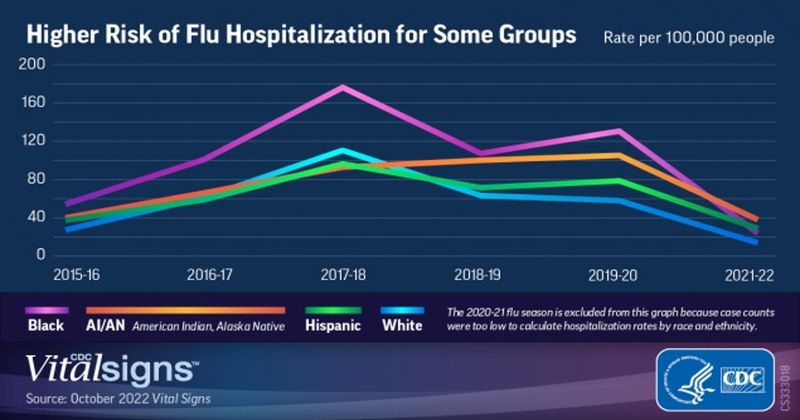Racial and ethnic disparities persist for flu vaccination, hospitalization
Adults who are part of underrepresented racial and ethnic groups are less likely to be vaccinated against influenza and are more likely to be hospitalized for it, according to health officials.
A new CDC Vital Signs report revealed the disparities. As a result, the agency is attempting to increase vaccination rates by raising awareness of influenza’s severity and tackling barriers to vaccination.

“For more than a decade, CDC has recommended annual flu vaccination for everyone 6 months and older as the best way to reduce the annual burden of flu. Still, only about half of Americans get a flu vaccine each year,” Carla L. Black, PhD, a CDC epidemiologist said during a press briefing held by the agency. “This Vital Signs report shows that people from some racial and ethnic minority groups are even less likely to be vaccinated against flu and are more likely to be hospitalized with flu.”
Since 2010, the CDC estimated that influenza has caused 12,000 to 52,000 deaths, 140,000 to 710,000 hospitalizations and 9 million to 41 million illnesses in the U.S. annually. Also in that time, Black, Hispanic and American Indian/Alaska Native (AI/AN) adults in the U.S. have seen consistently lower vaccination rates, even though “vaccination is the best defense we have against the worst outcomes of getting the flu,” Debra Houry, MD, MPH, acting principal deputy director of the CDC, said during the briefing.
Last year, vaccination rates were:
- 54% among white and Asian people;
- 42% among Black people;
- 41% among AI/AN people; and
- 38% among Hispanic people.
“Last year, people who were vaccinated were 35% less likely to get sick than people who had not been vaccinated. On average, vaccination has been shown to reduce the risk of illness by 40 to 60%, but I will also say that even people who do get sick after being vaccinated are less likely to have severe outcomes like hospitalization and death,” Black said.
She added “there are many reasons for disparities in vaccine uptake,” like misinformation and distress, missed opportunities to vaccinate, lack of access to health care and insurance, and that “racism and prejudice also contribute to these inequities.”
When compared with white adults, hospitalization rates are nearly 20% higher for Hispanic people (RR = 1.2), 30% higher for AI/AN people (AI/AN; RR = 1.3) and 80% higher among Black people (RR = 1.8), according to the report.
“We can't really quantify the contribution of vaccination and other factors to hospitalization, but certainly there are other factors,” Houry said during the briefing. “One big one is the presence of chronic illnesses contributes to more severe flu outcomes, and Black Americans and some other racial/ethnic minorities are more likely to have chronic illnesses than white adults. And also factors like crowding housing conditions, access to health care; those also contribute to hospitalization.”
Black said there are several things that the CDC is doing to improve influenza vaccine uptake, like working with a vaccine equity program and partnering with AMA and the Ad Council for the third year to target specific messages toward Black and Hispanic Americans.
“Last year, CDC Director Dr. Rochelle Walensky declared racism is a serious public health threat that directly affects the well-being of millions of Americans. We recognize that racism is the root cause of many health disparities,” Houry said. “Dr. Walensky’s declaration reaffirmed our commitment to addressing the challenges driven by structural factors like racism, discrimination, historical disenfranchisement that deeply impacts communities.”
When asked about what the 2022 influenza season might look like, Black answered that “flu is unpredictable” and that they cannot predict the severity.
“It's very early. What we can say so far is that we've had two mild flu seasons, and this means we might be ripe for a severe season because people are not taking all the measures they took for COVID, which also had an impact on flu, like masking and social distancing,” Black said. “There's less natural immunity out there. People are going back to work. People are traveling again. All of these factors could contribute to us having a more severe flu season.
“We, of course, want everybody to get vaccinated; the Healthy People 2020 target for flu vaccination is 70%,” Black continued.
With this year’s severity unknown, Houry said that “now is the time for federal, state and local partners to make sure that communities have the additional resources they need.”
“This is a much-needed action to achieve health equity and to sustainably address disparities in flu vaccination coverage and flu outcomes,” Houry said. “As today’s Vital Signs report confirms, we still have much to do.”

